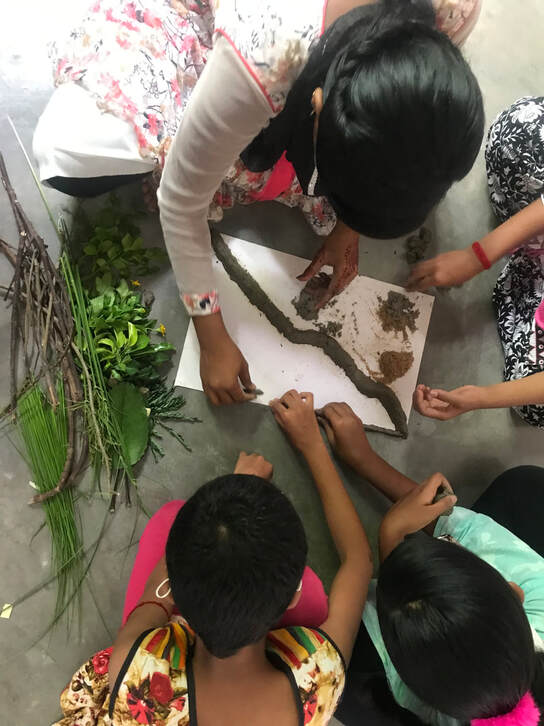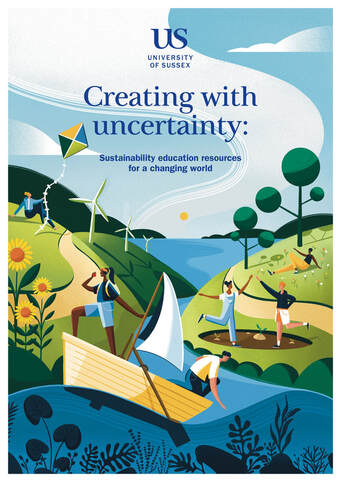TiE: ACTIVITY EXAMPLES
|
The new free online publication, Creating with Uncertainty: education resources for a changing world, offers a range of activities that can be adapted to all stages of education, from early years to secondary school, and we have also used the resources with students in higher education. It is designed to support students to attend closely, dig deeply, and engaging with complexities of climate change and biodiversity loss in their everyday lives.
It consists of 10 on the ground sustainability topics, each offering different topics to enrich curriculum across the curriculum. They engage students philosophically and practically to work towards a more sustainable world. |
Detailed below are some additional activities being used with children and young people in the Global South and North. Please also share with us your experiences of working with 'uncertainty'.
Climate change uncertainty in the Global North (primary school age)
Several activities explored with teachers in the UK on engaging children in climate change uncertainty are discussed in our short ASPE Bulletin article for primary school teachers .
Below is an activity on deforestation using Dr Seuss's The Lorax book and 1972 animation.
Below is an activity on deforestation using Dr Seuss's The Lorax book and 1972 animation.
Read more
The Lorax is great to read in the woods and here are some suggestions of how to use this story:
- Invite the children to draw out their own themes within this rich alliterative story; allow the children to engage with their own ideas and thoughts about what is happening in the story; and to identify the themes that are significant for them.
- Ultimately, this is a story of hope that ends with a myriad of possibilities. It could be read and discussed before 'imagining different futures' (see the secondary school age activity suggestions for ideas on how to do this), offering a segue to imagine the 'what next' and the possibilities for a different future with alternative values.
- There are many metaphorical possibilities in this story where the 'made up words' stand for other things/objects/animals/feelings. This presents a plethora of opportunities for children to represent their own versions of aspects of the story suing made-up words, and for these to be played out in different ways which could be recorded/dictated for repetition over and over (including being read/played-out to younger children, for example, who would love the 'nonsense' words, of course).
- There are other themes to be explored - who 'speaks for the trees' now? How might I/we 'speak for the trees'? This presents some wonderful opportunities for 'tree facts' such as those presented in the book, The Hidden Life of Trees by Peter Wohlleben , that is full of fascinating facts that some children might love about the way in which they are interconnected and 'talk to' and protect one another in times of 'hardship' and flourishing. It's also full of hope about all that trees enable/provide in terms of biodiversity and support for the living world for thriving. This might be linked to planting a tree. See Just One Tree.
- Significantly, it is the child (along with the Lorax), who seems to suggest the possibility for a different future . . . You might want to explore how in Dr Seuss's (1954) Horton Hears a Who! it is (similarly) the youngest child that shouts out and helps the animals. You could ask why they think Dr Seuss has focused on children. Depending on how the conversation goes, it might prompt discussion on the roles of children and adults in tackling climate change (which is likely to generate different perspectives).
Climate change uncertainty in the Global South (secondary school age)

We have worked with partner organisations to engage students (12 to 18 years) in two regions of the Global South where communities experience climate change and related sustainability issues, as well as high poverty and Covid-related homelessness/joblessness:
This is been done using creative and deliberative activities, and the young people share discuss their artworks and thinking with wider community stakeholders, including scientists, local policy makers, NGOs, teachers and residents.
Read more for some examples of the creative-deliberative activities being used.
- Sundarbans, India: has regular cyclonic storms, flooding and destruction of build/natural environments, and displacement; plus salinity and erosion of soil; and biodiversity loss.
- Lowland foreest region of the Ecuadorian Choco, Ecuador: livelihoods are tied to large-scale deforestation causing water-shortages; food insecurity; and biodiversity loss.
This is been done using creative and deliberative activities, and the young people share discuss their artworks and thinking with wider community stakeholders, including scientists, local policy makers, NGOs, teachers and residents.
Read more for some examples of the creative-deliberative activities being used.
read more
1. Making masks about what matters: Young people in India were invited to choose their preferred creative medium to show what is important to them and to express something about their living conditions, fears, daily hassles, cultural diversity, and their local environment and climate uncertainty.
Some chose to make models, including endangered (e.g. tigers) and extinct animals (e.g. water buffalo); goddesses and gods; and symbols of death (e.g. skull). Discussions supported the young people to explore the complexities and tensions in what they had said is important to them and what they had chosen to represented with their masks.
2. Future visioning and model making: Young people in India were invited to imagine, in groups, the Sundarbans that they want for their own children in 2045. Together, using plants, other found objects and clay they built their visions. They could choose whether to make something literal or metaphorical, and to use the plants/materials in any way they liked. As they crated their artworks, they were asked to think and discuss some important questions:
Adaptation: young people mentioned that they wanted to have professional jobs because farming is insecure.
3. Re-imaginging using colours and storying: in both India and Ecuador, young people were critical of deforestation. In India, one group wrote a song about the 'mindless' cutting down of trees. In Ecuador, a young person took photos of litter, and they made a model of trees, a river and a cabin, telling the story of a man who works in the forest and cuts down the trees to sell, resulting in no fish or animals: 'That is why we must take care of nature and take care of all of us'. These young people were asked to think further about the complexity of deforestation in their communities, by imagining themselves to be someone who cuts trees:
Some chose to make models, including endangered (e.g. tigers) and extinct animals (e.g. water buffalo); goddesses and gods; and symbols of death (e.g. skull). Discussions supported the young people to explore the complexities and tensions in what they had said is important to them and what they had chosen to represented with their masks.
- How might people live alongside tigers if their numbers are increased? If we take action to preserve endangered species, what might we have to give up/lose to achieve this, do you think? What is lost by the absence of the water buffalo? What makes you say this? What is the desirable balance of different species of animals and plants? Who decides?
- How do goddesses/gods reveal what is valued by people living in the Sundarbans? Can you give examples? What would be lost if the importance of goddesses/gods was forgotten? What makes you say that? Tell me about any tensions between the ideas of goddesses/gods and scientific knowledge? What importance do you place on the goddesses/gods and science in your own life - does this create any conflict or do they offer you something different?
- What is striking is that you use symbols of death and the end of human life to symbolise vulnerability of the Sundarbans. Can you tell us more about why you made this connection? What do these symbols mean to you? If death is associated with Sundarbans vulnerability, what gives you comfort in your life?
2. Future visioning and model making: Young people in India were invited to imagine, in groups, the Sundarbans that they want for their own children in 2045. Together, using plants, other found objects and clay they built their visions. They could choose whether to make something literal or metaphorical, and to use the plants/materials in any way they liked. As they crated their artworks, they were asked to think and discuss some important questions:
- What will your children's lives be like?
- What would you want to pass on to them?
- How would you like their lives to be different?
- Will they or others loose out in any way?
- How can this vision be achieved?
Adaptation: young people mentioned that they wanted to have professional jobs because farming is insecure.
- What will you preserve and what will need to be adapted?
- If you all have professional jobs, who will do the farming?
- If you are all doctors, teachers, lawyers - who will pay you? If you buy things with your increased salary, what will do this do for the Sundarbans?
- What knowledge and expertise will you need for your vision to happen?
- How will local knowledge be passed on?
- Who will know local plants and their medicinal uses?
- Who will know about how to adapt agricultural/farming practices?
- Who will know about how to adapt engineering practices?
- Who will be the politicians? What will they do?
- Would tourists be welcome? What would you want them to take away having spent time in the Sundarbans? What would you teach them?
- What would make it not worthwhile for people to poach?
- What will be the role of the goddesses/gods in your children's lives?
3. Re-imaginging using colours and storying: in both India and Ecuador, young people were critical of deforestation. In India, one group wrote a song about the 'mindless' cutting down of trees. In Ecuador, a young person took photos of litter, and they made a model of trees, a river and a cabin, telling the story of a man who works in the forest and cuts down the trees to sell, resulting in no fish or animals: 'That is why we must take care of nature and take care of all of us'. These young people were asked to think further about the complexity of deforestation in their communities, by imagining themselves to be someone who cuts trees:
- If you imagine yourself as the person who cuts down the trees - can you tell me what you think s/he is thinking and feeling as s/he does this? S/he may feel/think many different things at the same time - what would you imagine them to be?
- Would you like to choose some colours (by making marks on paper, or choosing objects or things in nature of different colours) to show the person's thoughts and feelings. What are you own thoughts and feelings about them cutting down trees to sell?
- What would you like to say to them and what things would they want to say back to tell you? Could you draw a storyboard?


